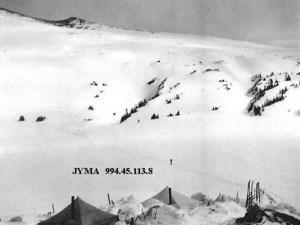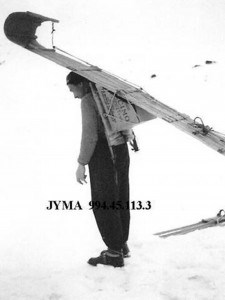Jasper National Park has a diverse and captivating backcountry ski history, which, in my opinion, rivals that of Banff National Park.
However, JNP unlike BNP has vast areas of wilderness now closed for caribou conservation, while the skiers in BNP still have access to their winter ski havens, such as Skoki, Lake O'Hara, Healy Pass and Shadow Lake. BNP can still make, maintain and propel its ski history, while JNP has been seriously hamstrung, leaving many of us concerned that JNP’s ski history will soon be a faded memory.
Before they are forgotten, through a series of stories, I plan to immortalize some of JNP’s overgrown, season constrained ski areas, portraying them as they were before the days of caribou closures. In doing so, I also hope to highlight some of Jasper's ski legends and pioneers, the very people who envisioned these ski meccas and loved their backcountry skiing as much as we do now.

Part One: Trapper Creek, the Rescue
In 1939, there was rip-snorting winter business up at Maligne Lake.
Fred Brewster, the owner/operator of Maligne Lake Chalet, quickly cottoned onto the ski boom, and provided transportation from Jasper, and served all 46 guests “excellent and healthy meals, including fresh meat and vegetables.” With rates as low as $5 per day and $32 per week there was an abundance of keen skiers more than ready to shred the Maligne Valley powder and gawk at its magnificent snowy vistas.
One of the many ski attractions was the winter tent camp way up on Trapper Creek, about 13 km from the chalet. Not to be confused with the Trapper Creek trail (first part of the Maligne Pass trail) which is open, this section of Trapper Creek is higher up, now part of Parks Canada's caribou closures.
Skiers would put their real seal skins on long wooden skis, right out the front door of the chalet, and merrily ski up the first part of the Maligne Pass trail, then beeline through an upper winter trail to pop out on Trapper Creek. This section of trail still exists, but the blazes are fading, the trees are growing and obscurity is a snowstorm away; only a few still know of its existence.
Once on Trapper Creek, the forest looses the battle, and alpine trees and willows take over, the views sublime.
Skiers snaked through an easy ascent over large meadows, up a small headwall to hit the end of the valley. For anyone that has skied in here, or has done the Six Pass Route, or the Evelyn Pass Loop, can visualize all this—skis making their beautiful spraying and swooshing arcs in the snow, while Empathy Peak dominates all.
On one particular trip, a skier fell and was injured, unable to ski out. The rest of the group was hit with a sobering dilemma: “how do we get this skier out?”
Someone volunteered to ski back to the chalet to get help—remember this was 1939, a time before handy phones, GPS Spots, or helicopters. However, there was innovation, fitness and strength.
Fred Brewster scoured the Chalet and surrounding area for a suitable rescue device, and a long wooden sled was procured from behind a storage building.

It must have been an epic ordeal, especially for Harold Taylor who hauled the toboggan up to the injured skier and strapped the unfortunate victim into place, before setting off on the long, bumpy and uneven descent back to the Maligne Lake Chalet.
Then came a triathlon journey; the injured skier packed into a sleigh pulled by horses was taken down to Medicine Lake. Once there, the horsey, hay snorts were replaced by the drone of a snowmobile as it sped across the lake to a waiting car, where all were stuffed in, for a twisty and windy survival descent, down the old Maligne Road to town.
Meanwhile, back up at the Maligne Lake Chalet, staff were preparing for the next batch of ski guests who were soon to arrive.
All good ski days eventually end; sometime in the 1950s, the winter tent camp way up in the splendour of Trapper Creek was dismantled, and the Maligne Lake Chalet closed its winter doors.
Looking back through the eyes of skiing history, it’s speculated that the development of the Whistlers Ski Hill and the area called Marmot Basin—whose skiing merit was first recognized by the legendary Joe Weiss—was the culprit that lured many powder seeking eyes away from Maligne.
Trapper Creek continues to flow, there is still ample snow, however the trail up to the creek has slumped into old age, into a form of forced retirement. Many savvy skiers over the last 75 years have followed the signs, setting a track through the many enticing alpine meadows, up to the snowy slopes dotted with alpine fir, but the blazes have succumbed to indiscriminate love.
The skiers' tracks have long since dissolved into the melt waters of the Maligne River.
But, oh, what this skier would give to be transported back into the glory days of the Maligne Lake Chalet, when you nonchalantly stepped out the door, put on your skins and glided your way up the beautiful Trapper Creek to the headwaters shadowed beneath a mountain wall, where a tent camp, insurmountable beauty and sparkly snow welcomed all.
Loni Klettl
Special to the 51����
